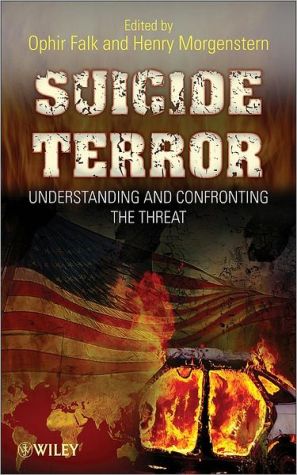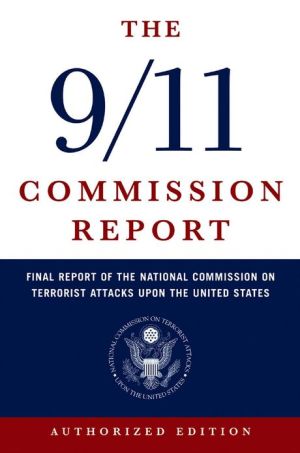Suicide Terror: Understanding and Confronting the Threat
"Ophir Falk and Henry Morgenstern have compiled a book that should be read by anyone who is serious about winning the war on terror. By painstakingly analyzing the empirical data, they help us better understand the nature of our enemies and why they employ these barbaric tactics. Most crucially, they offer important insights on how terrorism can be effectively confronted and ultimately defeated. In so doing, they have performed an invaluable service for all those who are committed to winning...
Search in google:
"Ophir Falk and Henry Morgenstern have compiled a book that should be read by anyone who is serious about winning the war on terror. By painstakingly analyzing the empirical data, they help us better understand the nature of our enemies and why they employ these barbaric tactics. Most crucially, they offer important insights on how terrorism can be effectively confronted and ultimately defeated. In so doing, they have performed an invaluable service for all those who are committed to winning this crucial battle."—Benjamin Netanyahu, Prime Minister of Israel FIRSTHAND ACCOUNTS AND ANALYSES FROM FRONTLINE PERSONNEL AND EXPERTS IN THE WAR AGAINST TERROR Based on U.S. and Israeli experiences and detailed interviews with frontline personnel, Suicide Terror enables policymakers, first responders, and students of homeland security to understand and deal with the growing threat of suicide terror. It analyzes recent suicide attacks as well as our current vulnerabilities and high-risk scenarios for future attacks. Following the expert authors' advice, readers learn possible measures to prevent an attack. Moreover, they learn how to prepare for and implement an effective and quick response to minimize casualties and losses in the event of an attack. Following an overview and historical review of suicide terror, the book covers: Global jihad Israel's confrontation with suicide terrorism America's experience with suicide bombings Internationalization of suicide terrorism High-risk scenarios and future trends Methods for confronting suicide terror Medical management of suicide terrorism Usingeyewitness accounts, the text re-creates the look and feel of actual terrorism incidents. Detailed case studies help readers get into the minds of suicide terrorists in order to understand how to best prevent and confront these very dangerous threats. This book is a definitive study of suicide terror, synthesizing the experience of well-known Israeli and American experts who have dealt with it firsthand. Anyone responsible for understanding, preventing, and confronting this devastating threat should read this book and consider its recommendations with all seriousness.
Preface xiAcknowledgments xvContributors xviiIntroduction: Overview And Historical Account Of The Weapon Ophir Falk 1Background 1Defining the Threat 2Definition Criteria 6Proposed Definitions 6Analyses of Data 23Overview 25Endnotes 261 The Global Jihad Henry Morgenstern 31Introduction: Where Is the Jihad Today? 31Do We Need to Know Why? 32The Meaning of Jihad for the Jihadists (Mujahedeen) 35The Origins and Evolution of the Global Jihad 35Osama bin Laden and Dr. Ayman al-Zawahiri-The Al-Qaeda View of the Jihad 36Support for the Global Jihad 41Seminal Ideas and Movements that Have Led to the Global Jihad 42Tauhid-The Oneness of God 42Takfir 43Jihad 43Jahaliyyah 44The Spread of the Jihad Across the World 46Case Study of Jihad Development: Egypt 47The Jihad in the United States 49Toward a Legal Definition of Terrorism in the United States 51Financing and Organization 53The Jihad: Version 2.0 56The Jihad's Virtual 007 57Real-Time Threat Example 59Understanding Techno-Intelligence Signatures 59Internet Activity and Terrorist Finance-Synergy in Cyberspace 60The Global Jihad Has a New Home Base-The Internet 61Conclusions 61Appendix 1 Internet Sites and the Global Jihad 62Appendix 2 Incidents in the United States since 9/11 63Endnotes 682 Israel's Confrontation With Suicide Terrorism Amir Kulick 73Background 73Arab-Israeli Conflict 73The First Circle: The Palestinian Suicide Bomber and His Motives 87The Second Circle: The Organizational Wrapping 91The Third Circle: The Social Wrapping 96How Has Israel Confronted Suicide Terrorism?105The Prevention Circle 107The Delay Circle 108The Consequence Mitigation Circle 109The Intelligence Level 110The Intelligence Challenge in the War on Suicide Terrorism 110Israeli Intelligence 112The Operational Level 118The Evolution of Israel's Responses to Suicide Terrorism- A Brief Historic Review 118The Israeli Methods of Action 122Targeted Killing 123Passive Measures 135Public Resilience 142Deterring Suicide Bombers 142Relevant Lessons for American Law Enforcement 144Key Lessons Learned-Operative Level 145Specific Lessons-Operational-Tactical Level 150Summary and Conclusions 155Endnotes 1573 The Eagle and the Snake: America's Experience With Suicide Bombings Yaron Schwartz 175The Origins of Suicide Attacks Against the United States 175Suicide Bombings in Iraq 179The Insurgency: Who, Why, When, and How 182The Role of Suicide Bombings 193Assessing the Surge 199The Impact of Iraq and Its Lessons 208Future Threats and Suicide Terrorism 213Endnotes 214Bibliography 2214 The Internationalization Of Suicide Terrorism Ophir Falk Hadas Kroitoru 225Lebanon 228Hezbollah 228Hezbollah's International Reach 231The Iran-Hezbollah-al-Qaeda Connection 233Hezbollah's Direct Threat to U.S. Homeland 234Sri Lanka 235A History of Conflict 235The Tamil Tigers and Suicide Terrorism 236Consequences and Counterterrorism Efforts 238Israel 241Historical Background 242A Decade and a Half of Suicide Terrorism 243Misconceptions 244From Deterrence to Prevention and Preemption 244Relevance to U.S. Homeland Security 247Operational Lessons 247India 248History of Conflict 248India's Experience with Suicide Terrorism 250Turkey 253Civil War and Civil Strife: The PKK's Answer to the "Kurdish Question" 253Turkey's Experience with Suicide Terror 254Islamic Groups Step Up to the Plate 258Turkish Counterterrorism Tactics 259Lessons from Turkey's Experience with Suicide Terrorism 261Al-Qaeda 262Establishing the "Base" 263Al-Qaeda Organization: Affiliates and Networks 264Al-Qaeda Attacks 266Al-Qaeda in Europe 269Al-Qaeda in Southeast Asia 273Consequences and Counterterrorism 274The Future of al-Qaeda 277Chechnya 278History of Conflict 278Chechen Separatists and Suicide Terrorism 279Consequences and Counterterrorism 288Summary and Conclusions-The Internationalization of Suicide Terrorism 289Endnotes 2905 High-Risk Scenarios And Future Trends Ophir Falk 301Scenario No. 1: Cyber and Physical Attack on Energy Distribution Systems 302Description of Scenario 302Vulnerability 305Consequence 305Means of Mitigation 306Scenario No. 2: Attacks on and by Civilian Aircraft-Back to the Future 307Description of Scenario 307Vulnerability 309Consequence 310Means of Mitigation 310Prosperity or Security in the Maritime Trade 311Scenario No. 3: Dirty Bomb in Maritime Container 312Description of Scenario 312Vulnerability 314Consequence 316Means of Mitigation 317Scenario No. 4: Blocking World Oil Transit by Sea Ofer Israeli 318Description of Scenario 318Vulnerability 320Consequence 321Means of Mitigation 324Scenario No. 5: PC Doomsday 325Description of Scenario 325Vulnerability 326Consequence 326Means of Mitigation 327Scenario No. 6: Suicide Terrorist Attack on Subway Followed by a Suicide Terrorist Attack on Premises of a Level I Trauma Center Shmuel C. Shapira 327Description of Scenario 328Vulnerability 328Consequence 329Means of Mitigation 329Future Trends 331Endnotes 3336 Methods For Confronting Suicide Terror William Cooper 341Detection of Key Terrorist Activities 346The Suicide Bomber 350Detection of Terrorist Recruitment in the Community 350Identifying Safe Houses and Planning Centers 353Terrorist means of Communication 355Identifying Terrorist Transportation 363Identifying Terrorist Financing 366Identifying Paper Falsification 366Land Attack Characteristics 367Sea Attack Characteristics 368Air Attack Characteristics 369The Public and the Battle Against Terrorism 370Legislation in the Battle Against Terrorism 371Negotiation Tactics to Use in Incidents of Terror 372Rules of Engagement 373Response to Suicide/Homicide Bombers 374Patrol Level Response 375Operational Philosophy 377Endnotes 3787 Medical Management of Suicide Terrorism Shmuel C. Shapira Leonard A. Cole 381Explosives 382Effects and Management of Suicide Terrorism 384Preparing for Suicide Terror Mass Casualty Incidents 387Mass Casualty Incident Management 389Pre-Hospital Management, Short Term 389Pre-Hospital Management, Prolonged Term 390Hospital Management of Suicide Terrorism 392Conclusion 393Endnotes 393Index 397








